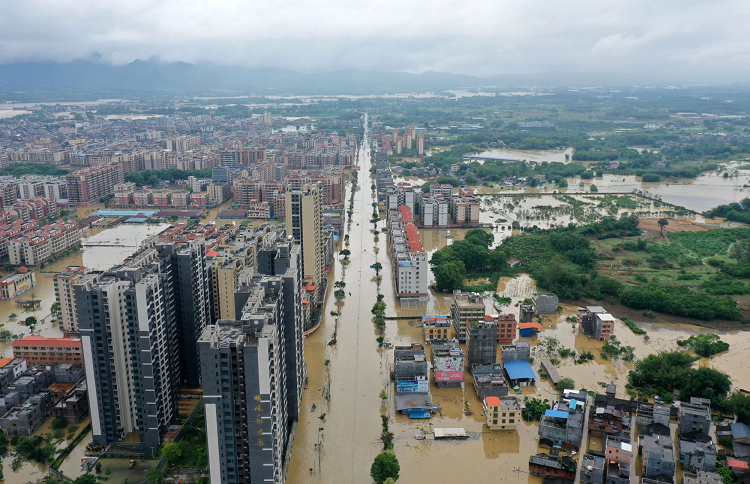
More accurate predictions expected to enhance disaster prevention, mitigation efforts.
Chinese scientists have recently proposed a novel artificial intelligence (AI)-based model to address streamflow and flood forecasting at a global scale for both gauged and ungauged catchments which remains one of the long-standing challenges in hydrology, given that more than 95 percent of small- and medium-sized watersheds worldwide do not have any monitoring data.
In light of global climate change, the frequency and intensity of extreme rainfall events significantly increased, leading to more frequent flooding disasters and more intensive flooding risks. Thus, the effective prediction of flood discharge serves as a crucial factor for reducing risks of flood disasters.
Despite the significant progress that has been made in physical process-based flood discharge prediction over the past few decades, forecasting results using current methods still heavily rely on monitoring data and parameter calibration. Recent progress and expansion in deep learning has made the AI technology-based data-driven models an alternatively novel solution of streamflow and flood forecasting in hydrological science.

A Chinese research team led by Ouyang Chaojun, a research fellow with the Institute of Mountain Hazards and Environment from the Chinese Academy of Sciences, proposed an AI-based novel streamflow and flood forecasting model to solve the streamflow and flood prediction problems at a global scale for both gauged and ungauged catchments. Data-driven models are critically dependent on the quality of historical data. The research team is leveraging historical data sets across 2,089 catchments from the US, Canada, Central Europe, and the UK with the data collection frequency of 24 hours and the time span between January 1, 1981 and December 31, 2009 to train the model, while also using historical data sets between January 1, 2010 and January 1, 2012 to verify the accuracy of the model’s forecasting capability, Ouyang told the Global Times.
According to Ouyang, generally speaking, examining a longer time span results in a richer data sets, despite having higher training costs. The significant diversity in the distribution of the data across these catchments ensures data variety, and tests the accuracy and reliability of the model in the predictions for future time periods. The verification results show that the model yields a mean Nash-Sutcliffe efficiency coefficient (NSE) of 0.75 – a commonly used score to assess the predictive power of hydrological discharge models – across 2,089 catchments, highlighting improvements by the state-of-the-art machine learning over traditional hydrologic models.
Based on the models pre-trained in the northern hemisphere, researchers conducted predictions on 160 entirely new river basins in Chile in the southern hemisphere without using any monitoring data, to test the model’s prediction ability in ungauged catchments. The prediction results of different pre-trained models show strong spatial distribution consistency. The model applied to 160 ungauged catchments in Chile shows 76.9 percent of catchments obtain NSE higher than zero in the best situation, demonstrating the potential of deep learning methods to overcome the ubiquitous lack of hydrologic information and deficiencies in physical model structure and parameterization. The model was recently published online through interdisciplinary journal The Innovation. This deep learning model can more effectively capture the spatial and physical attributes within the catchments.
In a world increasingly accustomed to wild weather swings caused by climate change, the last few weeks have taken those environmental extremes to a new level. According to media reports, hundreds of people were killed over the weekend after a series of deadly floods in Brazil, Afghanistan and Indonesia, the latest disasters after severe storms and flooding killed hundreds of people in Brazil, Kenya and Tanzania, and devastated Dubai and Oman, in the last two weeks. Local officials warned of increasingly impactful weather events and scientists linked the deadly deluges to human-caused climate impacts worsened by the ongoing El Nino which has caused significant climate changes on the global sphere.
Through this study, the model has demonstrated an enormous potential for streamflow and flood prediction across regions at a global scale. It is expected to enhance disaster prevention and mitigation efforts significantly if it is integrated with existing disaster forecasting systems to establish a real-time warning platform across various time scales, from days to hours to minutes.

Sources:
- The China Academy, May 14th, 2024. https://chinaacademy.substack.com/i/144611254/chinese-scientists-propose-ai-based-model-to-address-streamflow-flood-forecasting
- Global Times, May 13, 2024. https://www.globaltimes.cn/page/202405/1312187.shtml